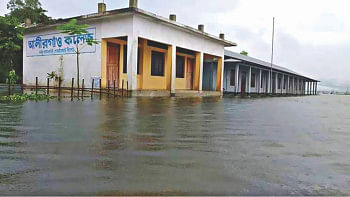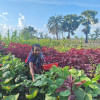Rising sea levels and the lessons to learn

Bangladesh's geographic location has given it a wealth of natural diversity while also making it vulnerable to many calamities. Floods, droughts, tides, coupled with rising sea levels, are typical throughout the year. The proximity of the Bay of Bengal to the country's south is particularly concerning, as the negative impacts of rising waters are already apparent. Over the next few decades, millions could be displaced if the at-risk Sundarbans and heavily populated coastal areas become submerged. By 2100, there could be a 0.4- to 1.5-metre rise in sea levels, which presents Bangladesh's islands with a possibility of going under.
In this situation, we may take lessons from strategies that other countries are using to combat this crisis. For example, due to its low elevation, the Netherlands is particularly susceptible to rising sea levels. So, its government has put in place measures such as creating greater space for rivers to lessen the risk of flooding, strengthening river dikes, building coastal dikes and seawalls, and investing in environmentally friendly urban development. Bangladesh has formulated the Delta Plan 2100, drawing lessons from the Netherlands' experiences.
Low-lying deltaic landscapes can be found in both Bangladesh and the Netherlands. However, Bangladesh does not have the financial, scientific, or technological resources to build raised sea fortifications. Furthermore, it is essential to incorporate adaptation measures for climate change into national and sectoral planning if these plans are to be in line with the nation's overarching objectives for sustainable development. A thorough and strategic approach is required to defend against the recurrent floods and climatic disasters Bangladesh faces.
Another example is Japan, whose resilient urban planning ideas could inspire Bangladesh's ability to anticipate and respond to disasters. In addition, Costa Rica's concentration on sustainable land management and reforestation provides insights into reducing the effects of climate change.
These strategies demonstrate the viability of targeted measures to increase resilience against floods and climate disasters, even though each solution may need to be modified to fit Bangladesh's context. The country needs to decide on how to cope with the challenge of sea-level rise, as farming and residential areas may become submerged. For instance, with climate change harming food production, researchers could develop a type of rice that can withstand flooding and salinity while providing a higher yield. Additionally, houses can also act as shelters, so people do not have to go far from their homes when floods occur. Similar initiatives have already been undertaken by some local NGOs.
The government has made some progress in protecting people and infrastructure from rising sea levels. Bangladesh has submitted multiple national communications to the United Nations Framework Convention on Climate Change and has formulated a 100-year delta plan. Its adaptation plans include water, flood, and erosion management, ensuring climate-resilient livelihoods, and various Ashrayan projects. Among all these, constructing a barrage on Brahmaputra and the Gorai River Restoration Project are the most important. Besides, lead authors for the Intergovernmental Panel on Climate Change include scientists from Bangladesh, who continue to conduct outstanding studies.
Many tactics can be used to reduce the risks of rising sea levels. But to use these, governments and communities must join hands and act quickly. At the same time, they must put effort into reducing greenhouse gas emissions to stop further global warming. The only way to save our planet and ensure a secure and sustainable future is by taking action urgently.
Antara Halder is a project associate at Bangladesh Institute of Governance and Management.

 For all latest news, follow The Daily Star's Google News channel.
For all latest news, follow The Daily Star's Google News channel. 










Comments